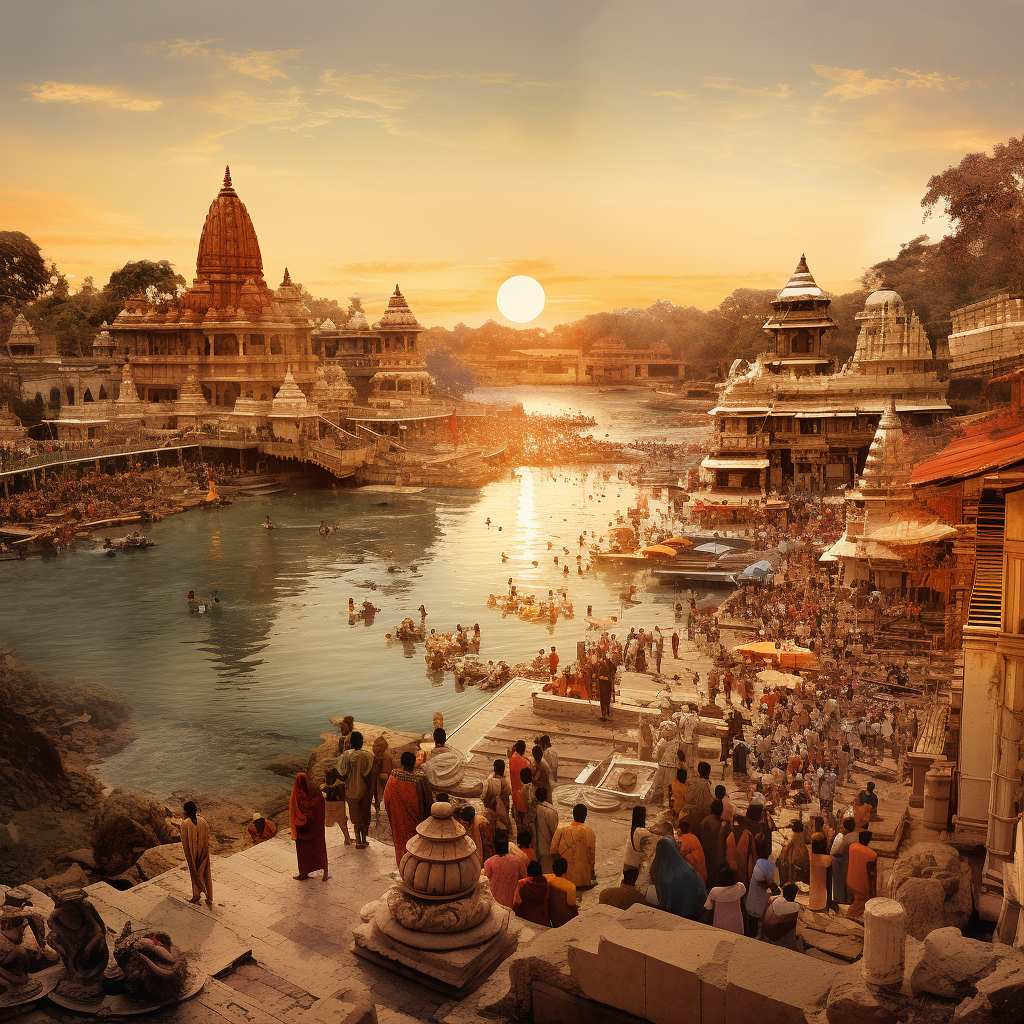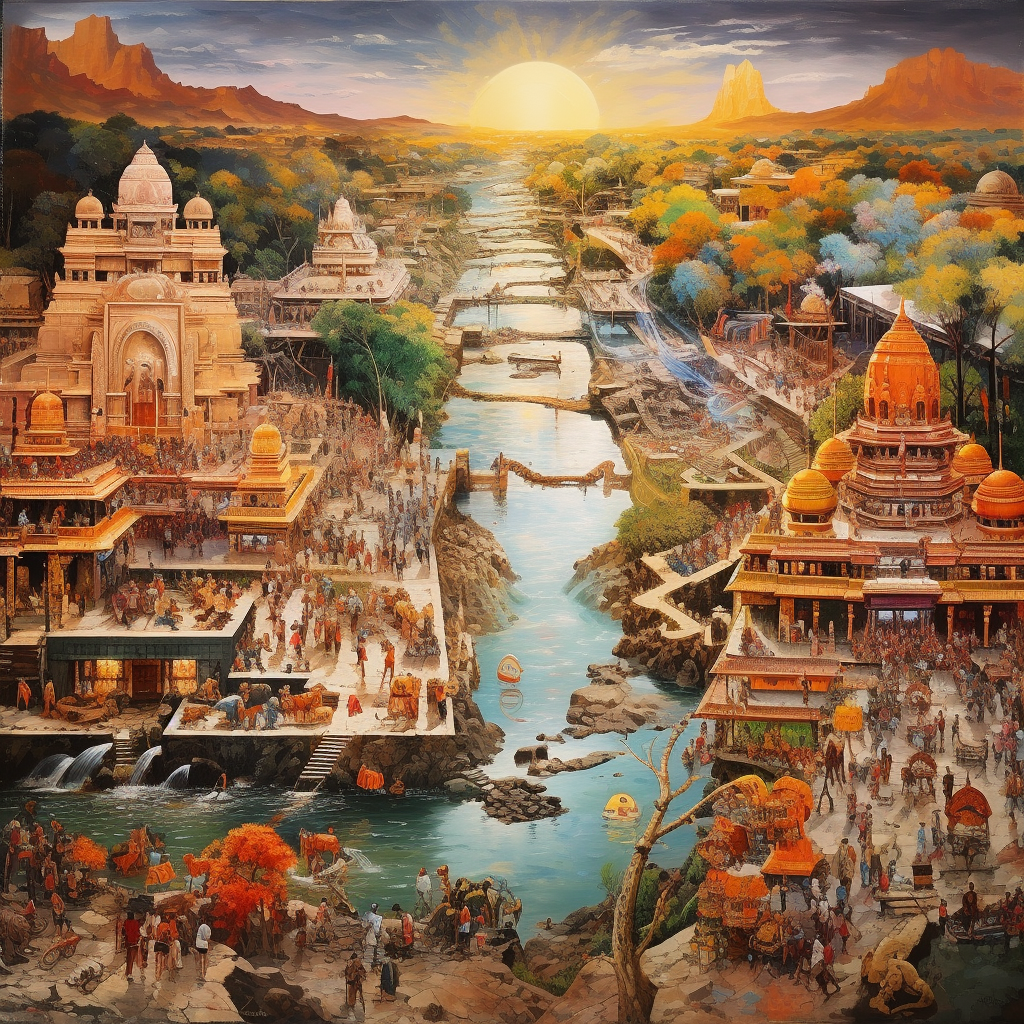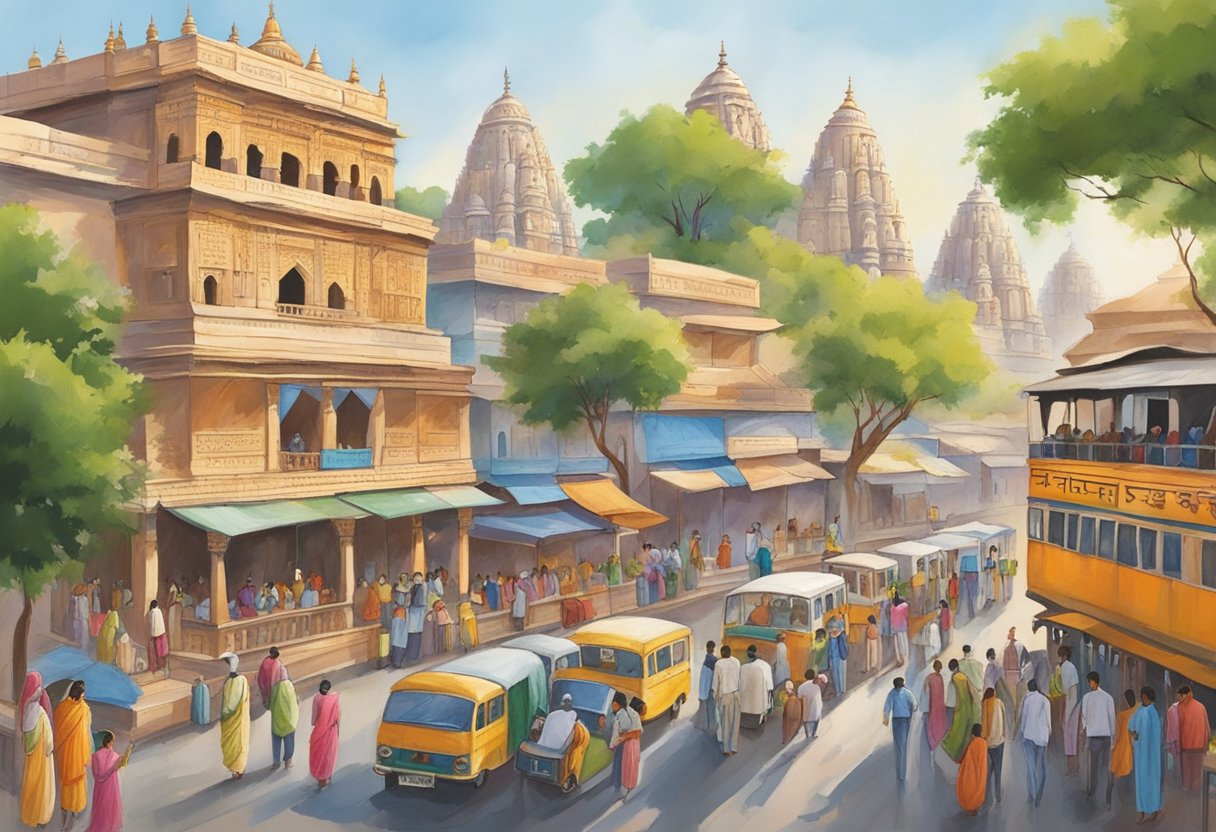Ujjain: Unveiling the Ancient City’s Mystical Charm
Ujjain stands as an ancient city of considerable historical and religious significance, located in the heart of India. In the Ujjain district of Madhya Pradesh, this city finds its roots deeply embedded in the cultural and spiritual tapestry of the country. Known for its ancient temples and as one of the locations for the Kumbh Mela, Ujjain attracts millions of pilgrims from all over the world, making it an epicenter for Hindu worship and rituals.

The city’s lineage can be traced back to a time when it was called Avantika, and it continues to be an educational and spiritual hub. Ujjain’s iconic temples, including the Mahakaleshwar Jyotirlinga, are a testament to its architectural brilliance and spiritual aura. The presence of the Shipra River adds to its religious sanctity, making the act of bathing in its waters a purifying ritual for many devotees.
Moreover, Ujjain’s contributions to astronomy and mathematics through the ancient observatory of the Vedha Shala underscore the city’s role in advancing science in bygone eras. As such, Ujjain is not only a site of deep religious significance but also a beacon of the historical and scientific intellect of ancient India. Its vibrant culture and profound legacy continue to draw researchers and travelers alike, all keen to witness the enduring charm of this timeless city.
Geography of Ujjain

Ujjain is a city with a rich historical backdrop, strategically located in the western part of the Indian state of Madhya Pradesh. It sits on the eastern bank of the Shipra River, which is a tributary of the Chambal River.
Latitude and Longitude:
- Latitude: 23 degree 17 minutes North
- Longitude: 75 degree 78 minutes East
The city is an integral part of the Malwa Plateau, which characterizes the region’s topography with a flat and undulating terrain. The elevation of Ujjain contributes to its moderate climate, with temperatures averaging at 24.0 °C (75.2 °F) annually.
Climatic Conditions:
- Temperature Range: Varies from warm to hot summers and cool winters.
- Monsoon: Receives rainfall during the monsoon season.
Ujjain’s geographical features have played a vital role in its development over centuries. The fertile land along the Shipra River has supported agricultural practices and contributed to the city’s sustenance.
The district of Ujjain, with the city as the headquarters, covers an area of 6,091 km².
Key Statistics:
- Area of Ujjain District: 6,091 km²
- Population: 19,86,864 (according to the 2011 census)
Ujjain’s geography not only shapes its climate and agriculture but also represents a confluence of history, culture, and spirituality.
History of Ujjain
Ujjain’s storied past begins with its ancient name, Avantika. It has long been regarded as a central hub for cultural and religious activities in India. Located in the Ujjain district of Madhya Pradesh, historical records align Ujjain with the fabled city of Ujjayini, which has been a part of the kingdom of Mahakal.
The timeline of Ujjain reflects its significance:
- Ancient Era: Ujjain emerges as a prominent city during the times of Buddha.
- 6th-7th Centuries: The city becomes a center for astronomical and mathematical research.
- Paramara Dynasty: The 9th to 12th centuries under the Paramara rulers, notably King Bhoja, marks a golden age.
The tumultuous periods in Ujjain’s history include invasions and battles:
- 1234 Invasion: Iltutmish’s forces desecrate the city, as documented here.
- Baz Bahadur’s Time: A period when the destructive tide against the city’s temples was stemmed.
Throughout its history, Ujjain has been recognized as one of seven sacred Hindu cities and remains a key site for pilgrimages, especially for events like the Kumbh Mela. Its profound legacy in mathematics and astronomy can be traced to the works of legendary scholars such as Brahmagupta and Bhaskaracharya.
The religious significance of Ujjain is highlighted by its dedication to the deity Mahakal, an aspect of Shiva, and is at the heart of the city’s identity.
Despite the historical upheavals, Ujjain retains a sense of its past grandeur, continuing to be an important city both spiritually and historically for India.
Cultural Significance
Ujjain emerges as a city with profound cultural heritage, with festivities and traditions reflecting its ancient significance. As one of the seven sacred cities in Hinduism, it holds a special place in religious observances. Mahakaleshwar Temple, a revered shrine among the 12 Jyotirlingas, draws countless pilgrims annually, becoming a focal point of cultural activities.
The city’s legacy extends to knowledge and education, historically recognized as a center of learning, especially in astronomy and astrology. Indeed, the very fabric of Ujjain’s culture is interwoven with its historical and mythological underpinnings.
Key Cultural Highlights:
- Kumbh Mela: Held every 12 years, it’s a major pilgrimage and one of the world’s largest religious gatherings.
- Simhastha: A bathing festival on the banks of the Shipra River, drawing millions of devotees.
Ujjain’s role in shaping cultural narratives is evident in its continued celebration of various forms of art. Religious festivals, temple rituals, and the city’s vibrant cultural scene articulate its storied past. Performances, literature, and local culinary traditions offer a window into the soul of this ancient city’s ethos.
Ujjain’s cultural fabric illustrates an enduring narrative, one that threads through its temples, festivals, and learned societies. Preserving its past, the city sustains its cultural significance through continuous practice and reverence for its traditions.
Temples and Architecture
Ujjain’s architectural grandeur is epitomized in its ancient temples, each showcasing remarkable craftsmanship.
Mahakaleshwar Temple
The Mahakaleshwar Temple stands as a significant religious landmark, housing one of the twelve Jyotirlingas. It features a distinctive three-storied structure embellished with intricate carvings that symbolize classical Indian architecture and spiritual ethos.
Kal Bhairav Temple
Dedicated to the fierce manifestation of Lord Shiva, the Kal Bhairav Temple is revered for its unique rituals and historic significance. The temple is an exemplar of the Maratha style of architecture, with its imposing walls and domes reflecting a legacy of devotion and artistry.
Harsiddhi Temple
The Harsiddhi Temple, renowned for its towering pair of lamps, is considered one of the Shakti Peethas. The temple’s design incorporates painted murals and stone carvings that illustrate mythological narratives, serving as a testament to Ujjain’s ancient cultural heritage.
Economy and Industries
Ujjain, historically rooted in the heart of India, has an economy that mirrors the blend of its rich cultural heritage with modern industry. The city’s economic fabric is woven with various sectors, including traditional crafts, a range of industries, and a burgeoning tourist trade.
Major Industries:
- Traditional sectors like handicrafts and textiles have been the city’s backbone.
- In recent times, tourism has seen significant growth due to Ujjain’s religious significance and its historical landmarks.
Economic Evolution:
- Earlier, the cotton industry played a substantial role, although many mills have since closed down, impacting the local economy.
- Diversification efforts have led to the development of other industries, fostering resilience and stability.
Tourism:
- With Ujjain hosting the Kumbh Mela, tourism has surged, substantially contributing to the local economy and providing new livelihood opportunities.
| Sector | Contribution |
|---|---|
| Handicrafts | Preserves cultural heritage and supports local artisans. |
| Textiles | Historically significant, undergoing transformation. |
| Tourism | Major revenue source; boosted by events like the Kumbh Mela. |
Financial data from 2019-20 suggests a Gross Domestic Product of Rs. 34,10,522 lakhs at current prices and Rs. 20,87,369 lakhs at constant 2011-2012 prices, underlining Ujjain’s economic potential.
For a detailed analysis of Ujjain’s economic dynamics and sector-wise information, refer to DistrictsOfIndia- Socio-economic statistical data of Ujjain District.
Education and Research
Ujjain, a city rich in historical and cultural heritage, is also a notable center for education and research in central India. Madhya Pradesh Institute of Social Science Research (MPISSR) is a premier institution in Ujjain, focusing on multidisciplinary studies across various social science spectrums. Established in 1983, it operates under the aegis of the Indian Council of Social Science Research and the Government of Madhya Pradesh.
The city’s educational framework is bolstered by numerous institutions that span from primary education to higher education and research. It majorly includes schools with robust educational programs and colleges offering undergraduate, postgraduate, and doctoral programs. Subjects range from traditional streams like arts and commerce to scientific and technical studies.
Ujjain’s significance in research is highlighted by initiatives such as educational interventions in local schools aimed at enhancing the knowledge and competence of students in critical areas. Such interventions often encompass lectures, multimedia presentations, and interactive sessions.
Here’s a quick overview of the educational infrastructure in Ujjain:
- Primary and Secondary Education:
- Private and public schools
- Emphasis on holistic development
- Higher Education and Research:
- MPISSR for social science research
- Colleges for arts, science, technology
- Specialized Programs and Interventions:
- School-based interventions for knowledge enhancement
- Research on social, economic, and contemporary issues
These educational facilities are accompanied by comprehensive research programs, investigations into social and cultural topics, and consistent scholastic advancements, reflecting Ujjain’s dedication to academic excellence.
Festivals and Events
Ujjain is renowned for its vibrant spiritual celebrations and grand festivals. Among these, two events stand out for their religious significance and cultural splendor: the Kumbh Mela and Mahashivratri.
Kumbh Mela
The Simhastha Kumbh Mela, specific to Ujjain, is an extraordinary gathering that occurs once every 12 years when certain astronomical positions are fulfilled. It attracts millions of pilgrims and sadhus seeking spiritual liberation by bathing in the holy Shipra River. The next Kumbh Mela in Ujjain is eagerly anticipated for 2028.
Mahashivratri
On the auspicious occasion of Mahashivratri, the city of Ujjain celebrates with great enthusiasm, as devotees flock to the Mahakaleshwar Temple. This significant event marks the convergence of Shiva and Shakti and is characterized by the observance of fasts, night-long vigils, and the reverberating chants of ‘Om Namah Shivaya’.
Tourism and Pilgrimage
Ujjain is a pivotal destination for tourism and pilgrimage in the heart of India, Madhya Pradesh. Known for its spiritual ambiance, the city attracts countless devotees who seek solace and spiritual rejuvenation.
The Mahakaleshwar Jyotirlinga, one of the twelve sacred Jyotirlingas, stands as a testament to the city’s centuries-old reverence for Lord Shiva. This temple draws a major portion of visitors, especially during the festival of Mahashivratri, illuminating the city with grandeur and devotion.
Ujjain also takes great pride in hosting the Simhastha (Kumbh Mela), one of the largest religious congregations on the planet, which takes place every 12 years on the banks of the Shipra River. During Simhastha, pilgrims from across the globe immerse themselves in the holy waters, a ritual driven by faith and tradition. For more insights into the spiritual significance of Ujjain, one can take a Virtual Tour of Ujjain.
Aside from the Mahakaleshwar temple, tourists can explore a variety of other poignant sacred sites:
- Gadkalika Temple, near the Bhartrihari Caves, captivates travelers with its ancient Hindu shrine, offering an immersive cultural pantheon (Trawell.in).
- Ram Ghat, especially during the entrancing Shipra aarti ceremony at sunset, showcases a spiritual spectacle along the ghats of the Shipra River.
Ujjain’s religious sites are complemented by its historical significance, amplifying the city’s allure for tourists interested in the cultural tapestry of India.
Transportation in Ujjain
Ujjain’s transportation network plays a vital role in the connectivity of this historic city. The Ujjain city has a limited road network, which is shaped by the presence of the Kshipra River, hindering extensive city expansion. Despite this, the city is well-managed with an array of transport options.
Public Transport in Ujjain includes:
- Local Bus Service: Operated by Ujjain Nagar Nigam, connects various city parts and even reaches the suburbs.
- Tongas: A traditional and cost-effective mode of transport.
- Auto-rickshaws: Widely available and offer flexibility for local commutes.
- Cabs: For a more comfortable travel experience, services like Ujjain Cabs provide well-maintained vehicles and experienced drivers.
The city is divided into the old and new sections, connected by a Road over Bridge (ROB) close to the city railway station. This ROB is a critical link, facilitating the movement of residents and tourists alike.
| Mode of Transport | Description |
|---|---|
| Buses | Affordable, covers most areas |
| Tongas | Traditional, suits short distances |
| Auto-rickshaws | Convenient for flexible routes |
| Cabs | Suitable for comfortable journeys |
Train services also contribute significantly to Ujjain’s transportation ecosystem, connecting it with major cities across India. For travelers looking to understand the layout of the city along with transportation options, interactive maps of Ujjain can be quite informative.
To summarize, Ujjain’s transport system, although constrained by geographical limitations, effectively serves its residents and visitors with a mix of modern and traditional transport options.
Cuisine and Gastronomy
Ujjain, an ancient city located in the heart of India, boasts a rich culinary heritage. The city’s cuisine reflects a blend of flavors influenced by its historical and cultural background.
Street Foods:
- Poha Jalebi: A typical breakfast combination found in Ujjain. Poha is a savory flattened rice dish, while Jalebi is a sweet and crispy pretzel-like pastry.
- Dal Bafla: A local variation of the famous Dal Bati, melding lentils with wheat dough balls.
- Sabudana Khichdi: Made from sago pearls, it is a common fast food that is both nourishing and light.
Local Dishes:
- Sabzi Poori: Wheat flour bread deep-fried and typically served with a spicy potato curry. This dish is well-known for the unique flavor imparted by frying in ghee.
Sweet Treats:
- Kulfi: A traditional Indian ice cream that comes in various flavors.
Eateries:
| Name | Specialty |
|---|---|
| Sai Palace | Located behind Mangalnath Mandir, known for authentic local cuisine. |
| Bhola Guru & Sons | Found in Chota Sarafa, famed for its sweets. |
| Sharma ji Chaat | At Chatri Chowk, celebrated for its variety of chaats. |
Visitors to this city can indulge in a gastronomic journey that provides a taste of Ujjain’s spiritual and festive life, manifested through its food. Each dish speaks to the city’s culinary expertise and the community’s inclination for flavors that tell stories of Ujjain’s past and present.
Notable Personalities of Ujjain

Kalidasa
Regarded as one of the greatest poets and dramatists in Sanskrit language, Kalidasa’s legacy in classical Indian literature is indelible. His works, like the play “Shakuntala” and the epic poem “Meghaduta,” are emblematic of his literary genius.
Varahamihira
The celebrated Indian astronomer, astrologer, and mathematician, Varahamihira, made significant contributions to the fields of trigonometry and algebra in the 6th century. His compilation, “Pancha-Siddhantika,” remains a crucial source for understanding ancient Indian astronomy.
Bhartrihari
This philosopher and grammarian is believed to have authored the “Vakyapadiya,” which discusses the philosophy of language and grammar. His thoughts on semantic analysis are profoundly influential in the development of linguistic theory in India.
Vikramaditya
A legendary king often associated with Ujjain, Vikramaditya is famed for his wisdom, valor, and patronage of the arts. Though his historicity is subject to debate, the tales of his court, known as “Navaratnas” or “nine gems,” reflect his celebrated status.

Leave a Reply